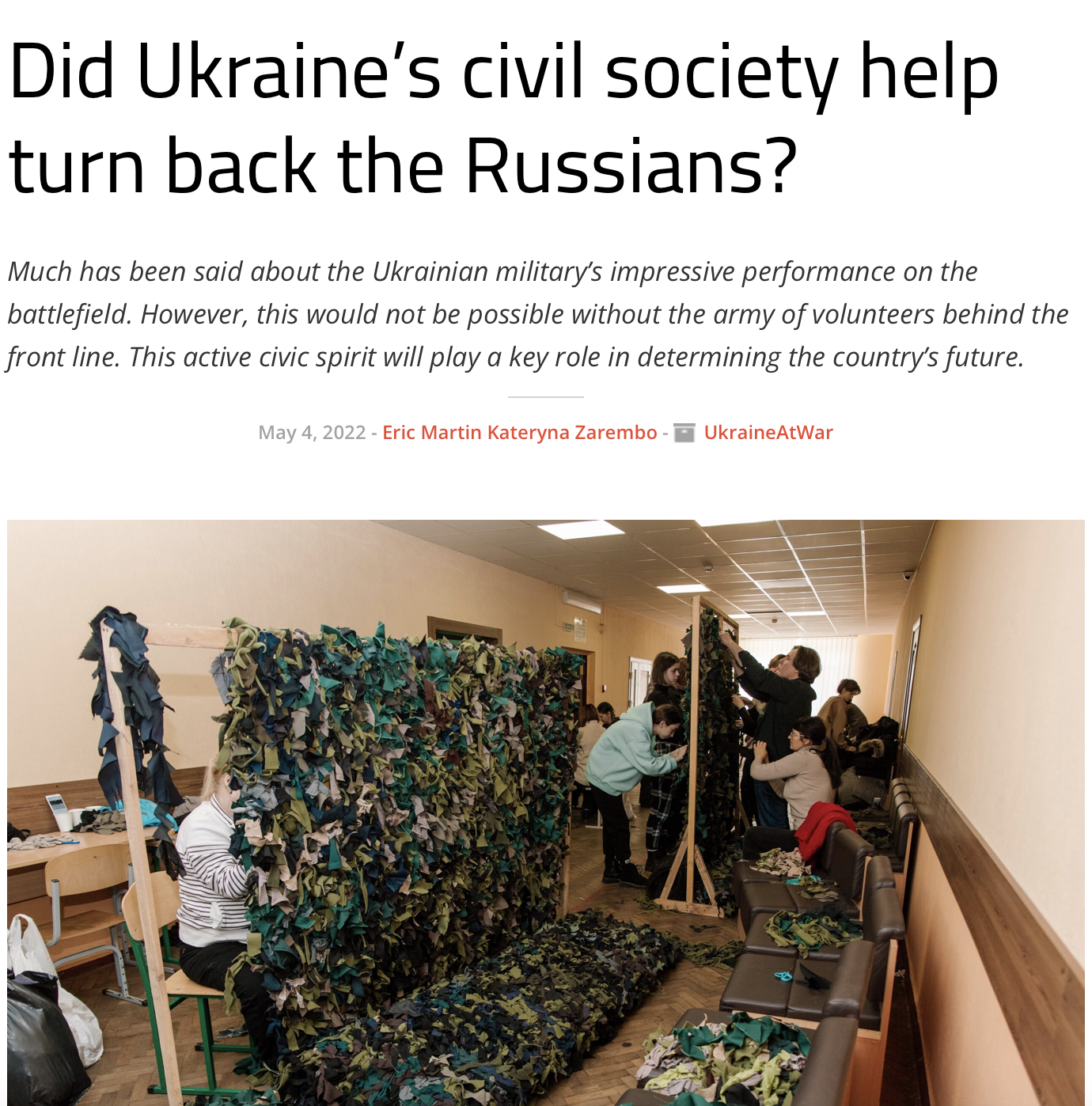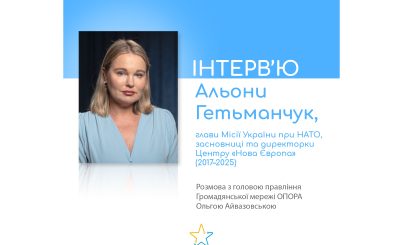Article by Kateryna Zarembo, New Europe Center Associate Fellow, and Eric Martin, Professor of Management in Bucknell University’s Freeman College of Management, for New Eastern Europe.
The New York Times ran a piece recently about the intelligence community misjudging the Ukrainian will to fight. The article suggested a pessimism regarding Ukraine’s military capacity to defend a seemingly hopeless position against a much greater power. Strategists across the board seemed to underestimate the Ukrainian military.
We believe Putin and the world may have also underestimated civil society in Ukraine.
Civil society refers to activity that takes place in the space between the state and the individual. In other words, it does not necessarily refer to individual acts of bravery, of which we have seen many. It also does not refer to government-led action, such as military defence.
It instead usually refers to the formal work of NGOs and is typically measured in terms of memberships, donations and volunteering. It also includes the philanthropic, altruistic and community-minded actions of businesses, civic groups, apartment associations, teams and clubs. Some see it as the moral fabric of a community.
In Ukraine’s case, it looks like civil society is more than a social fabric or glue. Indeed, it is the country’s foundation. It may be more active when the need arises, or more passive when there is less of an urge for participation. However, civil society in the country seems to be so important and powerful as to even become a synonym for Ukraine’s political nation. As The Economistsuggested on April 16th, “Being Ukrainian is not rooted in a particular territorial claim, or a certain ethnic background, or an allegiance to a particular state and its institutions, or the profession of a given faith. It is instead about the ability to come together when you feel that you need to and to get things done.”
The power of polling
Participation data may offer a different picture. For example, the Democratic Initiatives Foundation reported in November 2021 that only four per cent of Ukrainians were actively involved in civil society organisation activities (another 15 per cent joined rarely). According to the same poll, only seven per cent claimed to be regular participants in community events, while 22 per cent donated money to charitable or civil society organisations in the last 12 months.
This stands in stark contrast with data from 2014. According to GfK Ukraine, 65 per cent of Ukrainians donated money to charity (the biggest share of this amount was donated to the military) and 15 per cent volunteered actively during this time.
Civil society research during the Euromaidan protests revealed high levels of informal and effective organising. This, coupled with a fierce patriotism after years of war with Russia in the Donbas, suggested that a powerful undercurrent of civil society did, in fact, exist in Ukraine. This is in spite of the low formal measures.
This allows us to conclude that while the formal activities may be important indicators, they do not tell the whole story. In the case of Ukraine, they were actually misleading. Civil society appeared weak, disorganised and unfocused. Instead, we believe it was simply dormant, poised to return in a powerful way when the country needed it the most. As we have already seen, it has certainly returned in this time of crisis for Ukraine.
Over the last 50 or so days, we have witnessed a true outpouring of civil resistance and organising for the common good across Ukraine.
As Rosaria Puglisi pointed out in her book A People’s Army: Civil Society as a Security Actor in Post-Maidan Ukraine, “the large-scale mobilisation of Ukrainian society is … arguably EuroMaidan’s, and its tragic aftermath’s, most far-reaching legacy.” Puglisi even went further, suggesting that “civil society has become de facto a security actor.”
This year, Ukraine’s civil society became a security actor yet again. Already by December, the Kyiv International Institute of Sociology had reported that 33 per cent of Ukrainians were ready to take up arms and 22 per cent were ready to engage in acts of nonviolent resistance. It is clear that the Euromaidan collective spirit had truly been rekindled. At this point in time, most Ukrainians still did not believe that Russia would actually invade.
The tide shifted even further on February 24th with Moscow’s full-scale invasion. Citizens began to support their fighting men and women in countless ways.
According to a survey by the Rating Group conducted on April 6th, about 80 per cent of respondents are now involved in defending their country in one way or another. While 45 per cent of the respondents donated money, 35 per cent volunteered and 18 per cent participated in information resistance (multiple answers were possible).
Societal action
Beyond the heroic individual efforts we have seen on TV, public and popular high-profile personalities, such as Eurovision winner Jamala or TV host Masha Efrosinina, have raised money and awareness regarding the conflict. Private schools such as A+, Optima and the European Collegium now offer free online lessons to all children. Kyiv restaurants Goodwine, Food vs Marketing, 100 Rokiv Tomu Vpered, Khlibnyi, and the Borysov network cook meals for the country’s defenders and anyone in need. The popular Ukrainian fashion brands MustHave and Kachorovska even provide protective clothing and boots for soldiers.
Big businesses such as retailers Rozetka and Fozzy Group, delivery service Nova Poshta, the Kyiv School of Economics, and many others have reoriented their efforts to fundraising and purchasing military gear. The two volunteer initiatives represented by these organisations raised 26 million US dollars in just 40 days of war. At the same time, the top Ukrainian charity foundation “Come Back Alive” raised 114 million dollars in the same period. This is in contrast to the seven million dollars that the foundation had collected in the eight years since May 2014.
Bureaucrats donned fatigues and weapons. Boxing legend Vladimir Klitschko joined his brother, the mayor of Kyiv, to defend his city and tennis star Alexandr Dolgopolov (alongside numerous other sport, music and showbiz figures) left his family to join the defence, drawing international attention to the cause.
These are all vivid examples of organised community activities that involve the private sector, armies of volunteers, extensive media coverage and coordination with the government. In other words, these are examples of civil society in action where the public, private and nonprofit spheres align.
A bright future
We have been collecting examples of civic action throughout the Russian invasion. These acts are often done in the face of grave danger by individuals and groups throughout the unified civil society of Ukraine. The power of Ukrainian civil society has drawn admiration from across the globe. It also motivates those risking their lives in armed combat. While the armed forces are to be commended for their bravery, the unsung heroes may be those sewing camouflage netting in subways and church basements, mixing batches of petrol for Molotov cocktails, cooking food, and sending blankets to the front.
As The Economist reported on April 2nd, President Zelenskyy “Sees strength in the grit of the humble, unarmed Ukrainians who ‘waved their hands in the middle of the streets in order to stop tanks … They decided to stand up and do this of their own volition. I could not have ordered them not to do it or to throw themselves under the tank treads.”
Civil society, which appeared to be a weak conglomeration of apartment associations, churches, and homeless shelters focused on the youth, the poor, and the neglected, became a powerful national unifying force for resistance and territorial defence.
Defending Ukrainian territory sparked this surge in civic action, as did the vision put forth by the protesters at both Euromaidan and the Orange Revolution. While ordinary times might not reveal the power of Ukrainian civic behaviour, these crises have sparked community organising time and time again.
Typical polls on civic activism do not seem to capture the spirit of civic pride and determination. Instead, they measure the more formal ways citizens engage with each other, such as belonging to clubs, donating funds, and serving on boards.
This spirit will be necessary in the clean-up, rebuilding and redevelopment of the country, whether that be in weeks, months or years. Ukrainians will need to tap into that civic spirit for a long time to come. In many post-war settings, that spirit must often be created by aid agencies seeking to build civil society as a necessary prerequisite for political development, democracy and institutional strengthening.
In Ukraine, however, it seems that it already exists in abundance. This deep reserve of community spirit will serve the country well as the war drags on, as deaths rise, and more atrocities are uncovered. The sense of community and more importantly, the sense of shared responsibility for action, will allow Ukrainians to help each other throughout the pain of war and the long difficult work of reclaiming their country. Ultimately, it will allow the population to restore Ukraine to what it once was just a few months back – and even better.
Kateryna Zarembo is a Lecturer at the National University of Kyiv-Mohyla Academy (Ukraine) and a Guest Researcher at TU Darmstadt (Germany). She is also an Associate Fellow at the New Europe Center.
Eric Martin is a Professor of Management in Bucknell University’s Freeman College of Management.









